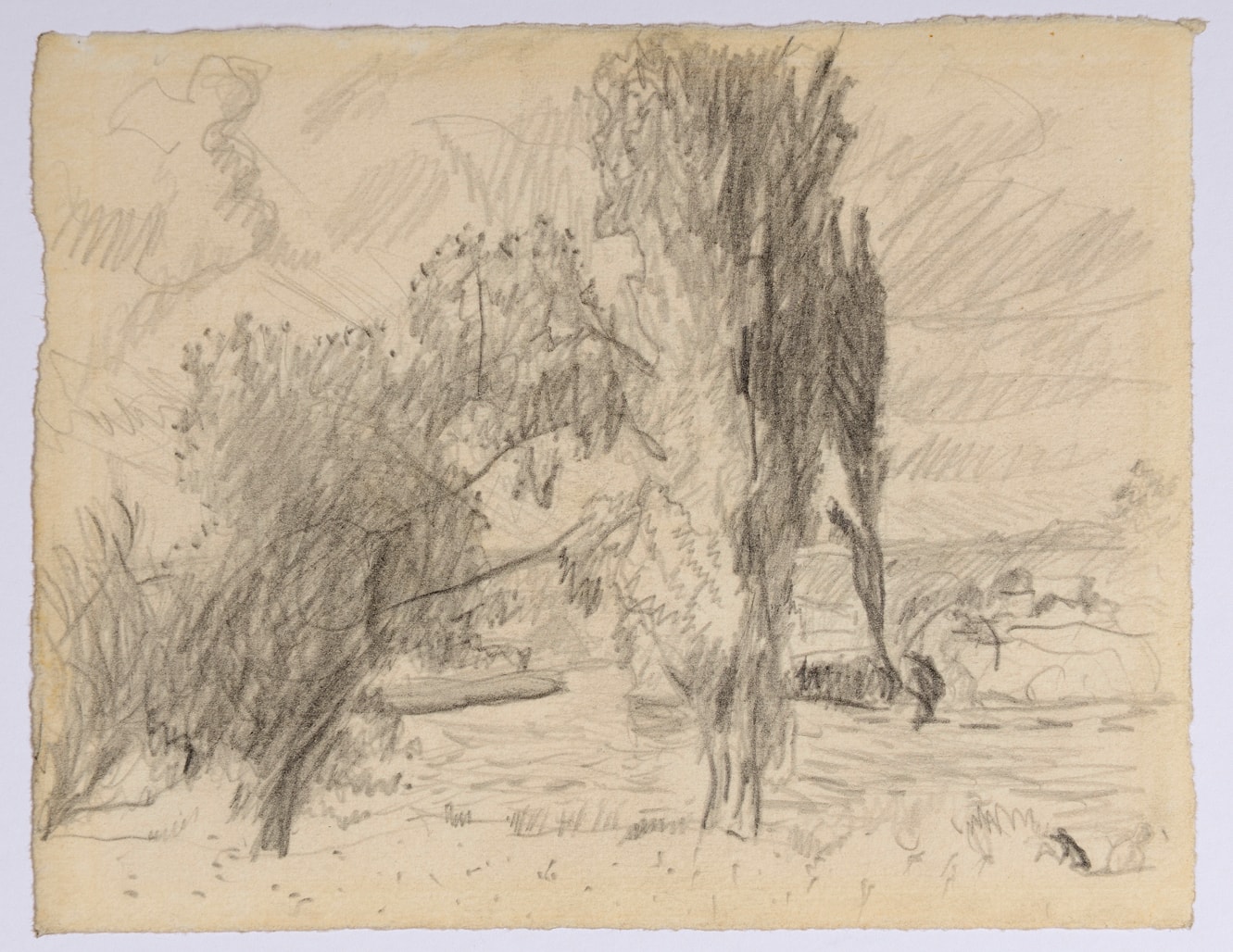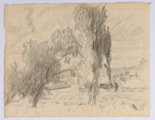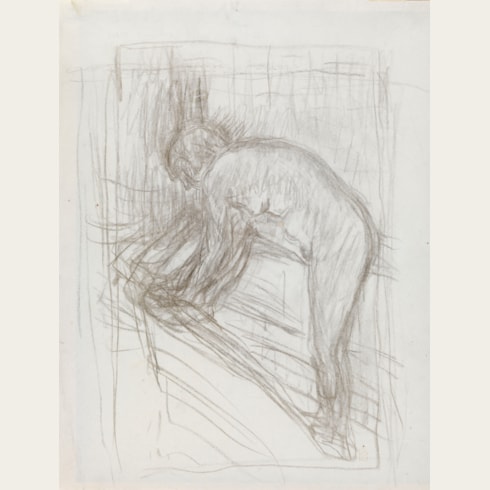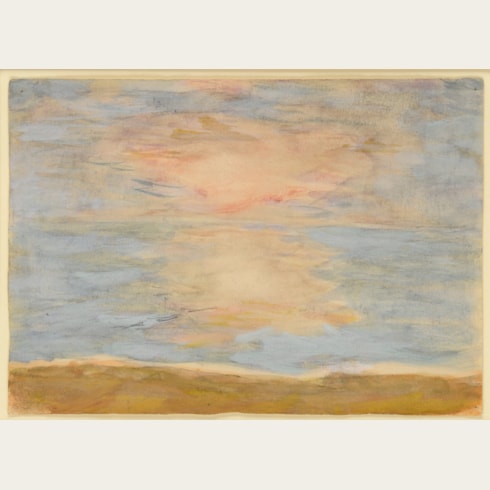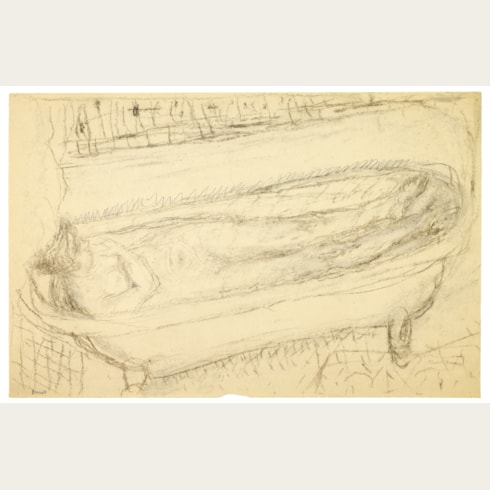Pierre BONNARD
(Fontenay-aux-Roses 1867 - Le Cannet 1947)
Landscape on the Seine near Vernon
Sold
Pencil, on a page from a small sketchbook.
128 x 166 mm. (5 x 6 1/2 in.)
128 x 166 mm. (5 x 6 1/2 in.)
In 1910 Bonnard began renting a house known as ‘Ma Roulotte’ (‘my gypsy caravan’) in the village of Vernonnet, just across the river Seine from the larger town of Vernon, near Giverny in Normandy. He bought the house outright in 1912, and worked there for the next sixteen years. The house enjoyed splendid views of the Seine, and Bonnard painted several views from its wooden balcony and windows. As Nicholas Watkins has noted, ‘He got to know the river extremely well on his daily walks and often explored it in his boat, kept on the little tributary, the Bras de ma Campagne, running between the Île Saint-Pierre and the bottom of his garden.’
Bonnard also made countless drawings of the views from of Ma Roulotte, many of which do not relate to a finished painting. Vernon was only three kilometres from Giverny, where Claude Monet lived and worked for thirty years, and the two artists became close friends. Bonnard sold the house in 1939, when he moved permanently to the South of France.
Bonnard also made countless drawings of the views from of Ma Roulotte, many of which do not relate to a finished painting. Vernon was only three kilometres from Giverny, where Claude Monet lived and worked for thirty years, and the two artists became close friends. Bonnard sold the house in 1939, when he moved permanently to the South of France.
A compulsive draughtsman, Pierre Bonnard relied on his studies and sketches extensively in the preparation of his pictures. Most of his drawings seem to have been made in the process of developing the composition of a painting, and indeed he seems to have preferred to work from drawings rather than relying on direct observation. He made use of whatever paper came to hand, sometimes lined or squared pages of cheap paper or small sketchbooks, and generally of a small enough size to fit into his pocket. He almost always used a hard or soft pencil and only very rarely applied colour to his drawings, relying on the strength and shading of the pencil strokes to suggest tone and colour. In conversation with his nephew Charles Terrasse, Bonnard noted that ‘I am drawing incessantly - after drawing comes the composition which must have a perfect equilibrium, a well constructed picture is the battle half won, the art of composition is so powerful that with only black and white - a pencil, a pen or a lithographic pencil, one arrives at results as complete and of a quality nearly as beautiful as with a whole arsenal of colours.’
Bonnard rarely parted with his drawings, which were never intended to be exhibited or, indeed, regarded as independent works of art. Nevertheless, the artist’s work as a draughtsman is crucial to an understanding of his approach to painting. As Jack Flam has written, ‘Bonnard’s drawings are often very small, and as a result they are frequently overlooked in discussions of modern drawing. But their formal variety and sensitivity of touch are remarkable, as is the often fluctuant nature of their imagery. Although many of Bonnard’s drawings seem like shorthand notations of visual information recorded for later use in paintings, they are nonetheless effective as independent entities precisely because of the intensity of perception they incorporate. They also demonstrate an extraordinary sensitivity to the nature of the medium itself, unadorned by elaborate technical procedures.’
Provenance
By descent from the artist to his nephew, Charles Terrasse, Paris
Thence by descent to his son, Antoine Terrasse, Fontainebleau
Thence by descent.
Literature
Antoine Terrasse, Pierre Bonnard, Paris, 1967, p.127 (where dated c.1930)
Antoine Terrasse and Hans R. Hahnloser, Pierre Bonnard, exhibition catalogue, Geneva, 1969, p.27, no.36, illustrated p.23
Lisbon, Fundação Arpad Szenes-Vieira da Silva, Pierre Bonnard, 2001, illustrated p.59.
Antoine Terrasse and Hans R. Hahnloser, Pierre Bonnard, exhibition catalogue, Geneva, 1969, p.27, no.36, illustrated p.23
Lisbon, Fundação Arpad Szenes-Vieira da Silva, Pierre Bonnard, 2001, illustrated p.59.
Exhibition
Milan, Palazzo Permanente, Pierre Bonnard, 1955 [ex-catalogue]; Munich, Haus der Kunst, and Paris, Orangerie des Tuileries, Pierre Bonnard: Centenaire de sa naissance, 1966-1967, no.203 (where dated c.1930); Tokyo, National Museum of Western Art, and Kyoto, National Museum of Modern Art, Bonnard, 1968, no.113; Geneva, Galerie Krugier & Cie., Pierre Bonnard, 1969, no.36; Rome, Villa Medici, Académie de France à Rome, Bonnard (1867-1947), 1971-1972, no.54 (lent by Mme. Antoine Terrasse), where dated c.1930; Milan, Palazzo Reale, Pierre Bonnard, 1988-1989 [unnumbered]; Lisbon, Fundação Arpad Szenes-Vieira da Silva, Pierre Bonnard, 2001 [unnumbered]; Giverny, Musée des Impressionnistes, Bonnard en Normandie, 2011, no.61 (where dated c.1920).

